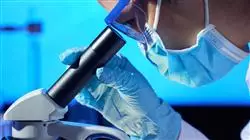University certificate
The world's largest faculty of medicine”
Introduction to the Program
You will have a comprehensive program based exclusively on biomedical signals, types, fundamentals and systems, processing, filtering, analysis, event detection and the software for their processing”

The continuous advances in Biomedical Engineering and the success of its application in real clinical cases has allowed to improve the diagnosis and, above all, the treatment of numerous pathologies in sick people. Knowledge of the most effective techniques has enabled professionals around the world to improve their professional practice and therefore the service they offer to their patients.
These reasons awaken in the specialist the need and the desire to invest in a degree with which to know in detail all the information that will also allow them to incorporate this set of techniques and procedures into their daily practice. That is why TECH has launched this program, to provide them with the best academic experience to achieve their goals quickly and comfortably.
This is a complete degree that covers the concepts necessary to master the field of biomedical signals, from types, fundamentals and systems to the best software for their processing. A syllabus
created by experts in the sector and aimed at medical professionals with which the specialist will be able to implement the best techniques.
A degree that is compatible with any work activity due to the flexibility and ease of being 100% online. In addition, the graduate will have all the content from the first day, thus facilitating the organization of the teaching process. You will also have at your disposal complementary material and individualized tutorials that will allow you to further your objectives during the Postgraduate certificate
The way this degree is organized will allow you to organize the program according to your own study patterns”
This Postgraduate certificate in Biomedical Signal Processing and Analysis is the most comprehensive and up-to-date educational program on the market. The most important features include:
- Practical cases presented by experts in Biomedicine
- The graphic, schematic, and eminently practical contents with which they are created, provide scientific and practical information on the disciplines that are essential for professional practice
- Practical exercises where the self-assessment process can be carried out to improve learning
- Its special emphasis on innovative methodologies
- Theoretical lessons, questions to the expert, debate forums on controversial topics, and individual reflection assignments
- Access to content from any fixed or portable device with an Internet connection
Implement the most modern and sophisticated techniques in electrocardiography, electroencephalography and magnetoencephalography in your daily life"
The program’s teaching staff includes professionals from sector who contribute their work experience to this training program, as well as renowned specialists from leading societies and prestigious universities.
The multimedia content, developed with the latest educational technology, will provide the professional with situated and contextual learning, i.e., a simulated environment that will provide immersive training programmed to train in real situations.
This program is designed around Problem Based Learning, whereby the professional must try to solve the different professional practice situations that arise during the academic year. For this purpose, the student will be assisted by an innovative interactive video system created by renowned and experienced experts.
Develop your full potential and expand your knowledge in only 150 hours with this Postgraduate certificate"

You will delve into, through real clinical cases, in the classification and examples of biomedical signals"
Syllabus
The content of this program has been designed following the guidelines of the relearning methodology, through which the most important concepts are repeated throughout the program, facilitating their natural and progressive acquisition. TECH is committed to the most modern and sophisticated pedagogical techniques, so by choosing this university, the graduate will be investing their time in a modern, quality degree that meets their personal and professional needs.

In the Virtual Classroom you will find all the additional content you need to complement the syllabus and set yourself apart from other professionals specializing in biomedical signals"
Module 1. Biomedical Signals
1.1. Biomedical Signals
1.1.1. Origin of Biomedical Signals
1.1.2. Biomedical Signals
1.1.2.1. Amplitude
1.1.2.2. Period
1.1.2.3. Frequency (F)
1.1.2.4. Wave Length
1.1.2.5. Phase
1.1.3. Classification and Examples of Biomedical Signals
1.2. Types of Biomedical Signals Electrocardiography, Electroencephalography and Magnetoencephalography
1.2.1. Electrocardiography (ECG)
1.2.2. Electroencephalography (EEG)
1.2.3. Magnetoencephalography (MEG)
1.3. Types of Biomedical Signals Electroneurography and Electromyography
1.3.1. Electroneurography (ENG)
1.3.2. Electromyography (EMG)
1.3.3. Event-Related Potentials (ERPs)
1.3.4. Other Types
1.4. Signals and Systems
1.4.1. Signals and Systems
1.4.2. Continuous and Discrete Signals: Analog vs. Digital
1.4.3. Systems in the Time Domain
1.4.4. Systems in Frequency Domain Spectral Method
1.5. Fundamentals of Signals and Systems
1.5.1. Sampling: Nyquist
1.5.2. The Fourier Transform DFT
1.5.3. Stochastic Processes
1.5.3.1. Deterministic vs Random Signals
1.5.3.2. Types of Stochastic Processes
1.5.3.3. Stationarity
1.5.3.4. Ergodicity
1.5.3.5. Relationships Between Signals
1.5.4. Power Spectral Density
1.6. Processing of Biomedical Signals
1.6.1. Processing of Signals
1.6.2. Objectives and Processing Steps
1.6.3. Key Elements of a Digital Processing System
1.6.4. Applications. Tendencies
1.7. Filtering: Artifact Removal
1.7.1. Motivation. Types of Filtering
1.7.2. Time Domain Filtering
1.7.3. Frequency Domain Filtering
1.7.4. Applications and Examples
1.8. Time-Frequency Analysis
1.8.1. Motivation
1.8.2. Time-Frequency Plane
1.8.3. Short Time Fourier Transform (STFT)
1.8.4. Wavelet Transform
1.8.5. Applications and Examples
1.9. Event Detection
1.9.1. Study Case I: ECG
1.9.2. Study Case II: EEG
1.9.3. Evaluation of Detection
1.10. Software for Biomedical Signal Processing
1.10.1. Applications, Environments and Programming Languages
1.10.2. Libraries and Tools
1.10.3. Practical Applications: Basic Biomedical Signal Processing System

The time has arrived. This is your opportunity to progress professionally with the best university and the best experts"
Postgraduate Certificate in Biomedical Signal Processing and Analysis.
Biomedical signals are those electrical, mechanical, chemical or magnetic signals produced by the organs and tissues of the human body. These signals contain valuable information about the physiological activity of organ systems, such as the nervous system, cardiovascular system, and respiratory system.
Biomedical signal analysis and processing are designed to measure, interpret, and modify these signals for diagnostic or therapeutic purposes.
Examples of biomedical signals include electrocardiographic (ECG) signals, electromyographic (EMG) signals, electroencephalography (EEG) signals, among others. These signals can be analyzed to aid in the diagnosis of biomedical diseases and disorders or for rehabilitation applications.
Modern biomedical signal analysis methods include digital signal processing techniques, machine learning algorithms and artificial intelligence technologies.
As for biomedical signal processing, it may include noise filtering and artifact removal, signal segmentation and pattern identification, automated event detection and classification, and measurement error correction.
The results of biomedical signal analysis and processing are a valuable tool for physicians and healthcare specialists, as they can improve the quality of diagnosis and treatment in patients with biomedical disorders and diseases.
This program provides a deeper understanding of different biological signals, methods to acquire them and signal processing. In addition, they may also include topics such as information theory, statistics and mathematical modeling. In addition, students can learn about biomedical sensors, signal analysis techniques and the application of these techniques in various areas, such as imaging, physiology and neurology.
The Postgraduate Certificate specializing in biomedical signal analysis and treatments is an excellent option for those interested in implementing new technologies in health care and in the application of new techniques in the diagnosis and treatment of diseases.







